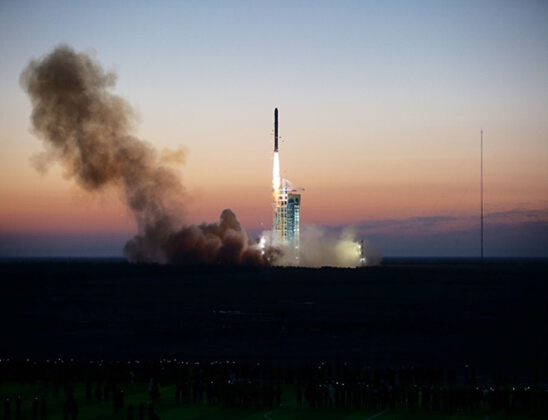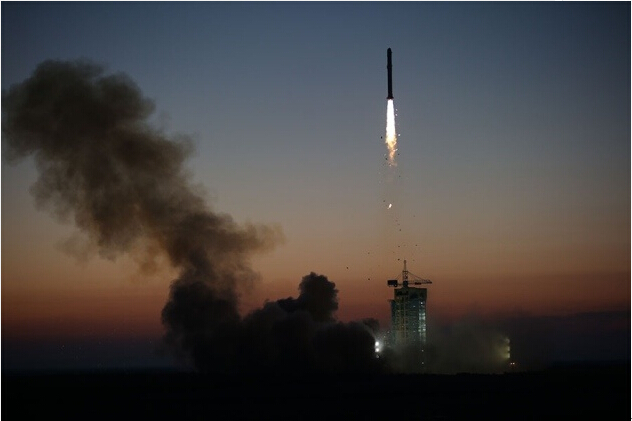


Wukong lifts off from the Jiuquan Satellite Launch Center in Gansu province of Northwest China.(Photo by Jin Liwang)
Against a purple morning sky, in a cloud of brown smoke, the Monkey King took off. China’s first space-based dark-matter detector — nicknamed Wukong (or Monkey King) after a fictional warrior in a sixteenth-century Chinese novel — rocketed into the air on 17 December, marking a new direction in the country’s space strategy.
From Earth’s orbit, the craft aims to detect high-energy particles and γ-rays. Physicists believe that dark matter — a substance so far observed only through its gravitational effects but thought to make up 85% of the Universe’s matter — could reveal itself by producing such cosmic rays as its particles annihilate.
But Wukong, more officially known as the Dark Matter Particle Explorer (DAMPE), is also notable for being the first in a series of five space-science missions to emerge from the Chinese Academy of Sciences’ Strategic Priority Program on Space Science, which began in 2011.
Change of direction
China is already one of the world’s major space powers, but so far has focused on human and robotic exploration, with little investment in actual space science. (A notable exception is the Double Star, a probe launched in 2003 to study magnetic storms).
Following DAMPE lift-off from the Jiuquan Satellite Launch Center in Gansu province of Northwest China, a further two missions will blast off next year: the world’s first quantum-communications satellite and an X-ray telescope observing in a unique energy band. Together, these missions mark a new start for space science in China, says Wu Ji, director-general of the National Space Science Centre (NSSC), which runs the program.
Other countries have had Moon missions, adds Pan Jianwei, chief scientist for the quantum-science satellite. But with the space-science satellites, “we can do something new and something really great and not only for China — for the whole world".
The public gave DAMPE its nickname Wukong earlier this week, part of a recent outreach drive in China’s space program; a similar public appeal also produced the name Yutu, or Jade Rabbit, for the nation’s lunar rover, which landed in 2013.
Wukong will use its large surface area to observe high volumes of cosmic rays, as well as where they come from. It will survey the sky at energies much higher than that of existing detectors such as the Alpha Magnetic Spectrometer (AMS), which is currently attached to the International Space Station. “We don’t know if this is a better way to search for dark matter, because dark matter has not yet been found,” says Mike Capell, an AMS physicist at CERN, Europe’s particle-physics laboratory.
Pulsar puzzle
The detector could help to clear up some mysteries. In 2013, the AMS indicated it had seen hints of dark matter but so far it has detected too few high-energy particles to say for sure. Though DAMPE lacks the equipment to resolve the conundrum directly, it could tell us if the signal is caused by a different astrophysical source, such as pulsars, says Capell.
Although it will collect fewer incoming photons, DAMPE is better at pinpointing their energy than are existing γ-ray telescopes, such as NASA’s Fermi-LAT, says Miguel Sanchez-Conde, a physicist at the Oskar Klein Centre for Cosmoparticle Physics in Stockholm. This capability should allow DAMPE to see sharp spikes in radiation predicted by some dark-matter models.
Following hot on Wukong’s heels come two experiments that are no less ambitious. The quantum-science satellite, to launch in June, will be the world’s first space experiment to probe the phenomenon known as quantum entanglement. The mission will test whether photons beamed to the satellite from two ground stations can remain entangled with their counterparts on Earth. It will also probe whether this quantum connection — stretching over a record-breaking distance of more than 1,000 kilometers — will allow information to ‘teleport’ instantly and securely between the locations. Previously, such experiments have transmitted photons through optic fibers, or air, on Earth and over much shorter distances.
The eventual goal is to create a global quantum-communications network, says Anton Zeilinger, a physicist at the University of Vienna in Austria who is collaborating with Pan on the quantum satellite. By pushing the limit of quantum entanglement, Pan says that the satellite will also help to solve fundamental mysteries about the Universe, such as how to unite quantum mechanics with Einstein’s theory of general relativity.

The launch of the DAMPE satellite marks a new direction in China's space strategy.(Photo by Jin Liwang)
Black holes
In the second half of the year, China will launch the Hard X-ray Modulation Telescope (HXMT), looking for bright and brief sources of radiation, such as growing black holes. The HXMT will do a broad sweep of the sky, with sensitivity at the top of its large energy range that exceeds that of existing wide-field telescopes, says Luigi Piro, an astronomer at Italy’s National Institute for Astrophysics in Rome.
All three are cutting-edge missions, with the potential to make real discoveries, says Wu, but the NSSC director is still not satisfied. Space science in China is funded in five-year cycles — receiving around 3 billion yuan (US$460 million) in the current round. As a result, unlike in the United States and Europe, there is no permanent funding, which makes it tough to make long-term plans. “We don’t feel it is secure,” says Wu. “It is better than nothing. But we are still catching up.” He believes that until China makes discoveries in space science, “we are not a real space power”.
The current funding round ends next year. Although Wu believes the Chinese Academy of Sciences will continue to support the program for another five years, which will only be confirmed next year. The funding will have to cover a further two missions — satellite Shijian-10 to conduct microgravity and life-sciences experiments and a space weather satellite known as Kuafu.
International contributions
Piro notes that most of the present and future Chinese scientific satellites include contributions from scientists worldwide. Such collaborations “sharpen scientific goals, optimize resources and avoid overlap”, he says. Zeilinger attributes China's pioneering work in space-based quantum communications to fast decision-making processes “oriented towards getting things done”.
In the United States, Congress passed a law in 2011 that prevents NASA from collaborating with China except in rare circumstances. By contrast, the European Space Agency wants to work with China and is already collaborating with the Chinese academy on a small near-Earth space-weather observatory, the Solar wind Magnetosphere Ionosphere Link Explorer (SMILE).
China has limited experience in space science, notes Joan Johnson-Freese, an expert on China’s space program at the US Naval War College in Newport, Rhode Island. In addition to politics, this has hampered China’s collaboration so far, she says, but the country is anxious to develop and establish its expertise.
Chinese scientists would like to collaborate with the United States, says Wu, but the severance of ties hurt the United States more than China. “It gave a good chance to the Europeans. The US should realize that.”
SOURCE: NATURE.COM